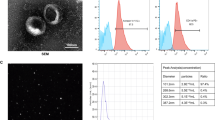Abstract
Background. We previously demonstrated that heparin-binding epidermal growth factor-like growth factor (HB-EGF) was expressed in rat mesangial cells and was involved in the progression of of glomerulonephritis in human and animal models. Soluble HB-EGF promotes cultured rat mesangial cell proliferation and the synthesis of type I and type III collagen mRNA. However, the precise role of proHB-EGF in mesangial cell function has not yet been clarified. In the present study, we address this question.
Methods. ProHB-EGF-transfected rat mesangial cells (MsC; MsCproHB-EGF) and empty vector-transfected rat MsC (MsCvector) were constructed. Cells were cultured in fetal calf serum (FCS)-containing (10%) or FCS-deficient medium, and the growth rates and numbers of surviving cells were determined. To elucidate the anti-apoptotic effect of proHB-EGF, cells were exposed to hydrogen peroxide (H2O2) or dexamethasone (DEX). Apoptosis was identified by qualitative and quantitative analysis. Expression of Bcl-2 protein in MsCproHB-EGF after exposure to apoptosis inducers was also evaluated.
Results. When cells were plated in a medium containing 10% FCS, the growth rate of MsCproHB-EGF was not different from that of MsC transfected with a plasmid alone (MsCvector). When cultured in the absence of FCS, MsCvector showed decreased cell numbers, indicating apoptotic cell death. In contrast, MsCproHB-EGF formed small colonies, although they did not show increased cell numbers, while cell viability was 90%–100% of the initial cell number after subculture. When quiescent MsC were exposed to DEX or H2O2, MsCvector exhibited significant DNA laddering, whereas MsCproHB-EGF showed resistance to these stimuli. The release of caspase-3 from MsCproHB-EGF after exposure to DEX or H2O2 was significantly lower than that from MsCvector. Bcl-2 protein expression was weak in MsCproHB-EGF at the baseline, but this expression was significantly upregulated after exposure to these stimuli. Confluent MsCproHB-EGF spontaneously expressed high level of p21 protein. Northern blot analysis revealed that MsCproHB-EGF expressed increased levels of type I and type III collagen mRNA and proteins compared with those of MsCvector.
Conclusions. These results indicate that proHB-EGF contributes to mesangial cell survival by promoting cell viability and by inhibiting apoptosis. The anti-apoptotic effect of proHB-EGF could be closely related to the upregulation of Bcl-2 and p21 expression.
Similar content being viewed by others
Author information
Authors and Affiliations
Additional information
Received: November 28, 2000 / Accepted: March 31, 2001
About this article
Cite this article
Yagi, K., Takemura, T., Hino, S. et al. Promotion of survival and prevention of apoptosis in rat mesangial cells by a membrane-anchored form of heparin-binding EGF-like growth factor. Clin Exp Nephrol 5, 177–185 (2001). https://doi.org/10.1007/s101570170008
Issue Date:
DOI: https://doi.org/10.1007/s101570170008




